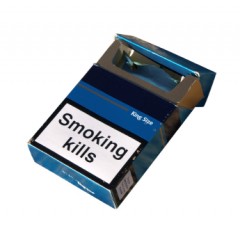Are Tobacco Warnings Really Ads?
 One of the startling conclusions from the neuromarketing study described by Martin Lindstrom in Buyology is that not only are the government-mandated warnings on tobacco packages ineffective, but they actually promote smoking behavior by activating the brain’s nucleus accumbens, an area associated with cravings. This counterintuitive finding was a highlight of Lindstrom’s Today Show interview. In Lindstrom’s words,
One of the startling conclusions from the neuromarketing study described by Martin Lindstrom in Buyology is that not only are the government-mandated warnings on tobacco packages ineffective, but they actually promote smoking behavior by activating the brain’s nucleus accumbens, an area associated with cravings. This counterintuitive finding was a highlight of Lindstrom’s Today Show interview. In Lindstrom’s words,
We couldn’t help but conclude that those same cigarette warning labels intended to reduce smoking, curb cancer, and save lives had instead become a killer marketing tool for the tobacco industry.
While I have no doubt that the brain studies are accurate, I think the interpretation needs to be studied carefully. Before the mainstream media starts calling for a removal of these insidious warning labels, let’s look at what’s really going on…
In another part of Buyology, Lindstrom notes the potent effect of imagery associated with tobacco brands. Red Formula 1 racing cars, rugged cowboys, and other images long associated with cigarettes (Marlboro, in those examples) were more powerful in stimulating the same craving center than the brand logo itself. Lindstrom suggests that the presence of overt advertising stimuli like a logo actually alerts the brain to the fact that it’s viewing a commercial message, while the cars and cowboys are more readily processed without the brain applying a “commercial” filter.
I think what’s happening with the tobacco warning labels is that they have become part of the “trade dress” of cigarette brands. While a bold warning that the product might kill you isn’t as appealing from a branding standpoint as a red Ferrari, there’s little doubt that being exposed to the warning labels many times per day for years has become part of the Marlboro experience. This would happen with anything you put on the cigarette packs. Put a picture of George Bush on every pack, and within a short time every time Bush was on TV you’d see smokers lighting up.
Do Warnings Do Any Good at All? Despite the depressing results of Lindstrom’s brain scans, there is the possibility is that even as some smokers see their tobacco craving increase by viewing a warning, that same warning might be processed consciously and increase the smoker’s resolve to quit. There’s no doubt that smokers experience powerful cravings when they quit, and it’s possible that the warning might be working at both the conscious and subconscious levels, albeit in opposite directions. The difficulty most smokers experience in quitting shows that the cravings usually win. As with most neuromarketing topics, the brain’s subconscious decision-making is a lot more powerful than we give it credit for.
That does leave the question of how one can accomplish the objective of reducing smoking by package modification. I don’t think that’s ultimately a real solution – just about anything you try to do could eventually become part of the branding. Perhaps occasional warnings that are very different, unexpected, and striking, could reduce the probability of becoming craving triggers? For example, what if one out of every 20 packs had an audio chip like those in greeting cards that played a funeral dirge? Or played the sound of someone coughing a lung up? I have no great confidence that this would work much better, but it’s clear the current warnings aren’t going to have much of an effect.
Give some credit to neuromarketing research for shedding light on why warnings have been so ineffective in cutting overall smoking rates.
